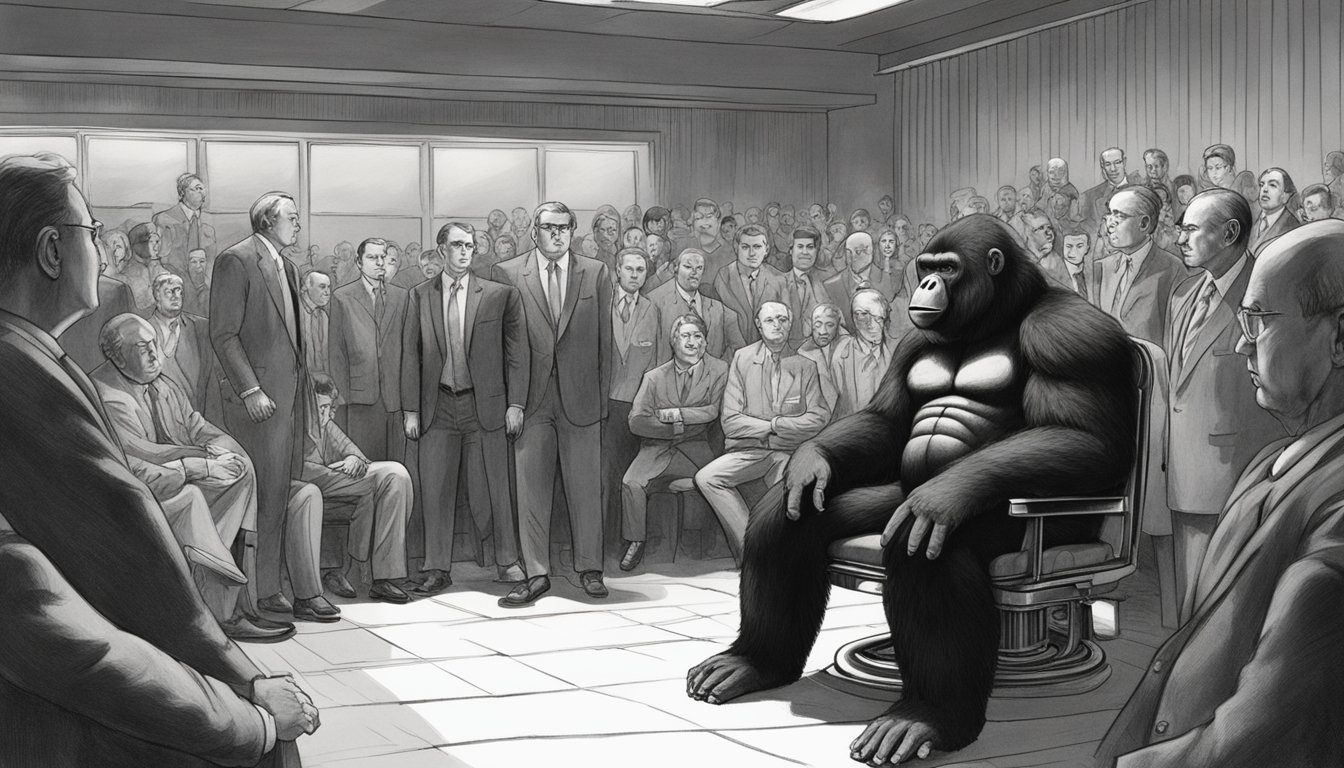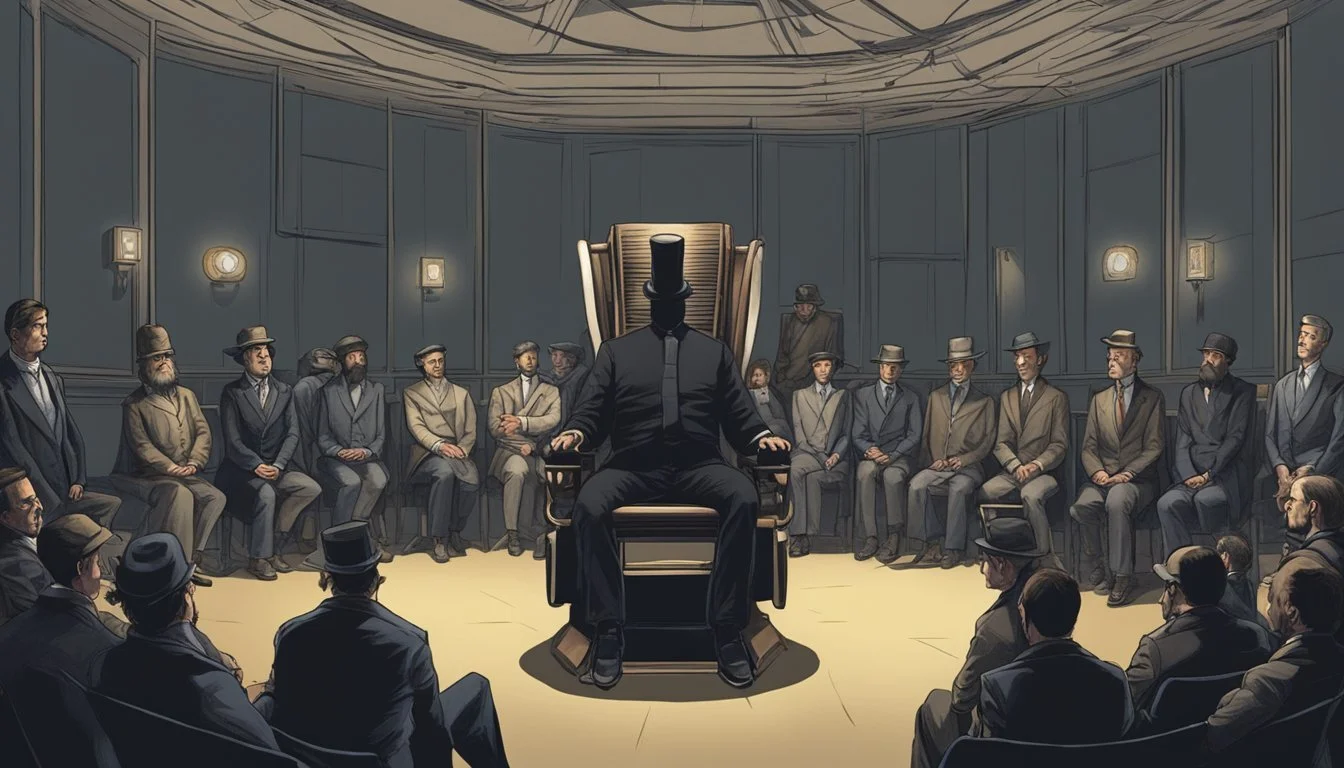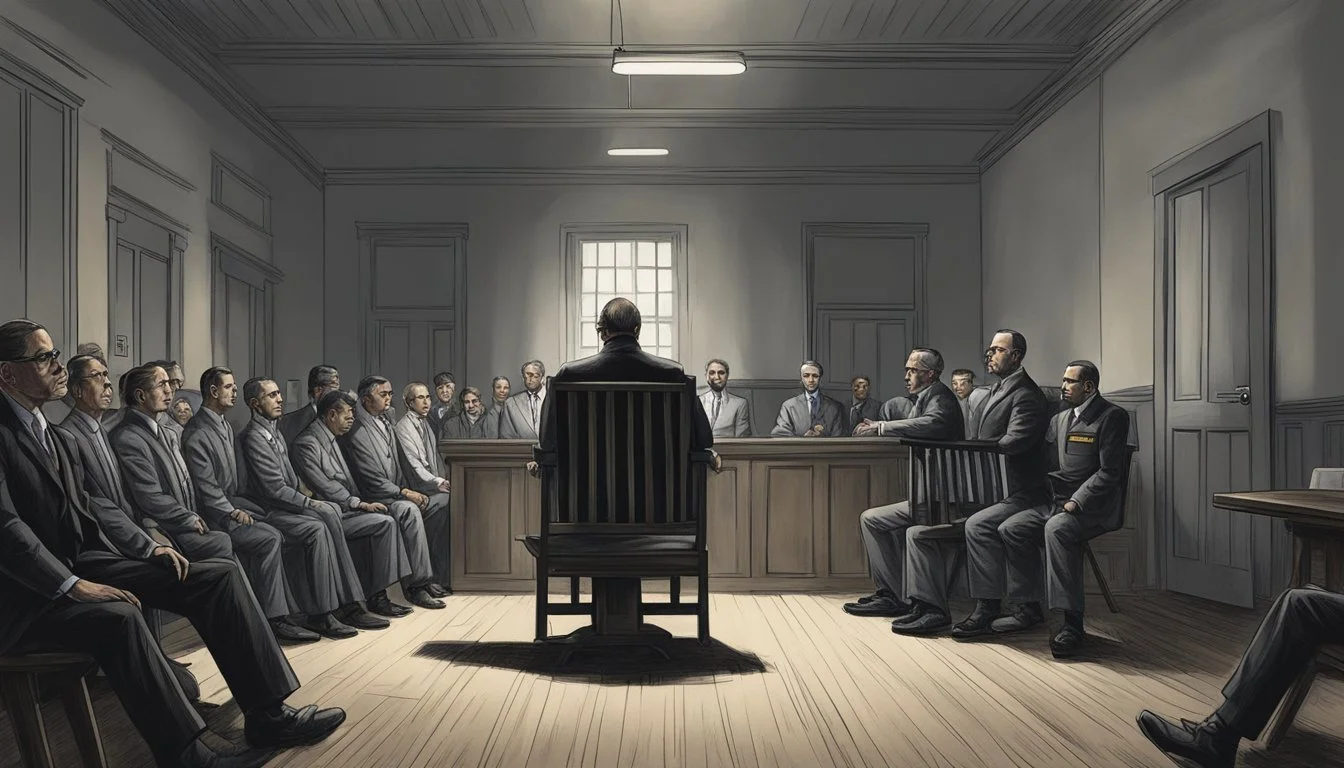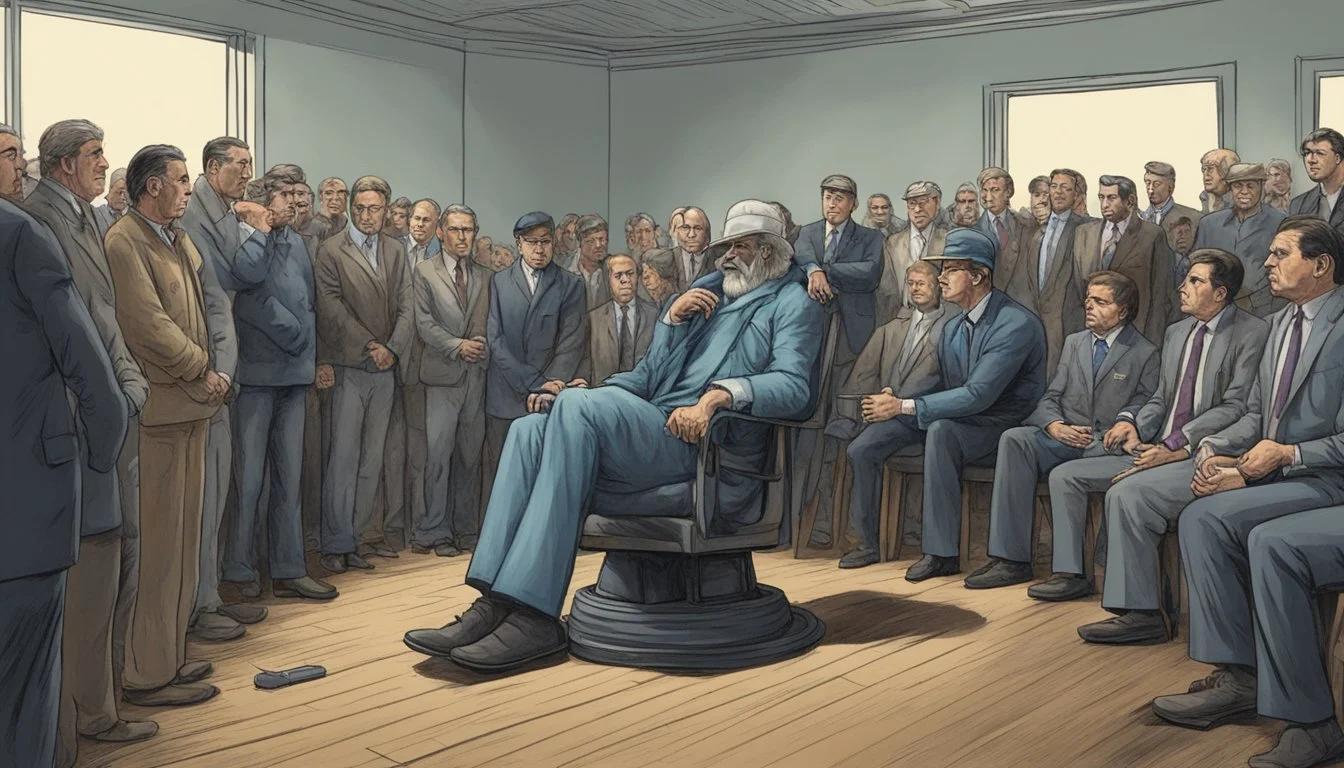Earle Nelson's Last Grab: Gorilla Man's Execution in the Electric Chair
Serial Killer Meets Justice in 1928
Earle Leonard Nelson, known as the "Gorilla Man" and "Dark Strangler," terrorized North America in the 1920s. This American serial killer left a trail of over 20 victims across the United States and Canada, earning him notoriety as one of the most feared murderers of the early 20th century.
Nelson's reign of terror came to an end in 1927 when he was captured in Winnipeg, Canada. His capture marked the conclusion of a gruesome spree that had begun in 1926, during which he targeted primarily landladies and other women who lived alone.
The "Gorilla Man" moniker stemmed from Nelson's powerful build and his method of attacking victims, which often involved strangulation. His crimes shocked the public and law enforcement alike, as the concept of a serial killer was not yet widely understood. Nelson's case would later be recognized as one of the earliest examples of serial murder in the modern era.
The Life of Earle Nelson
Earle Nelson's life was marked by tragedy, mental instability, and a descent into criminal behavior. His troubled upbringing and experiences shaped the man who would become one of America's most notorious early serial killers.
Early Years
Earle Leonard Nelson was born on May 12, 1897, in San Francisco, California. Orphaned at a young age, Nelson was raised by his maternal grandmother, a devout Pentecostal. His childhood was tumultuous, marked by a serious head injury at age 10 when he collided with a streetcar. This incident may have contributed to his future mental health issues.
Nelson exhibited signs of mental instability early on. He experienced hallucinations and religious delusions, which led to multiple hospitalizations. At 14, he was institutionalized at Napa State Mental Hospital, where doctors diagnosed him with a "constitutional psychopathic state."
Military Service and Mental Health
Nelson enlisted in the U.S. Army during World War I, but his military career was short-lived. His mental health continued to deteriorate, and he was discharged after being diagnosed with "epilepsy with clouded states."
Following his discharge, Nelson's behavior became increasingly erratic. He was arrested several times for petty crimes and spent time in various mental institutions. His struggles with mental illness persisted, manifesting in paranoid delusions and violent outbursts.
Patterns of Crime
Nelson's criminal activities escalated in the mid-1920s. He developed a pattern of targeting landladies, gaining access to their homes under the pretense of renting a room. Once inside, he would strangle his victims and often engage in necrophilia.
His crimes spanned multiple states and even crossed into Canada. Nelson's strength and agility earned him the nickname "The Gorilla Man." He managed to evade capture for months, leaving a trail of at least 22 victims across North America.
Nelson's mental state likely played a significant role in his crimes. He often claimed religious motivations for his actions, demonstrating the intersection of his delusions and violent tendencies.
Timeline of Murders
Earle Nelson's murder spree spanned multiple states and left a trail of victims in its wake. His crimes shocked communities across America in the 1920s.
First Known Crimes
Nelson's killing spree began in San Francisco, California in 1926. His first documented victim was Clara Newman, a 60-year-old landlady. Nelson strangled Newman and sexually assaulted her corpse.
Shortly after, he murdered Lola Cowan, a 14-year-old girl in San Jose. These initial crimes established Nelson's modus operandi:
Targeting lone women
Gaining entry under false pretenses
Strangling victims
Engaging in necrophilia
Killing Spree Across America
Nelson's murders escalated rapidly as he traveled across the country. Key locations and victims included:
Portland, Oregon: Emily Patterson
San Francisco: Laura Beale
Buffalo, New York: Lillian St. Mary
Philadelphia: Ollie Russell
He often posed as a plumber or handyman to gain access to his victims' homes. Nelson earned the nickname "Gorilla Man" due to his powerful build and brutal method of strangulation.
The Final Victims
Nelson's last confirmed victims in the United States were:
Mary Nisbet in Portland, Oregon
Blanche Myers in Council Bluffs, Iowa
He then fled to Canada, where he murdered Emily Patterson and 14-year-old Lola Cowan in Winnipeg. Canadian authorities finally apprehended Nelson on June 15, 1927.
In total, Nelson was linked to over 20 murders across North America. His capture brought an end to one of the most notorious killing sprees of the early 20th century.
Earle Nelson's Modus Operandi
Earle Nelson, known as the "Gorilla Man" and "Dark Strangler," developed a distinctive method for his crimes. He targeted vulnerable women, particularly landladies and those living alone.
Nelson's approach involved responding to "room for rent" advertisements. He gained trust by presenting himself as a polite, well-mannered gentleman seeking lodging.
Once inside, Nelson's demeanor changed drastically. He attacked his victims, strangling them with his powerful grip. This earned him the nickname "Gorilla Killer" due to his strength and brutality.
Nelson often engaged in necrophilia after the murders. He frequently stole small items from his victims' homes before fleeing the scene.
His killing spree spanned multiple states and even crossed into Canada. Nelson's ability to move quickly between locations made him difficult to track.
Key aspects of Nelson's modus operandi:
Targeted vulnerable women
Responded to "room for rent" ads
Gained entry through deception
Used strangulation as murder method
Engaged in post-mortem sexual acts
Stole small items from victims
Nelson's crimes shocked the early 20th century public, marking him as one of the first known serial killers of the era.
Arrest and Escape Attempts
Earle Nelson's reign of terror ended with his capture in Canada, but not before a daring escape attempt. His distinctive physical characteristics and fingerprints played a crucial role in his identification and eventual conviction.
Capture and Identification
Earle Nelson's crime spree came to an abrupt halt on June 15, 1927, in Winnipeg, Manitoba. Police apprehended him after the murder of 14-year-old Lola Cowan. Nelson's unique physical features, including his protruding jaw and slouched posture, matched eyewitness descriptions.
Fingerprint evidence linked Nelson to multiple crime scenes across North America. Authorities in Canada and the United States collaborated to build a case against the serial killer. Nelson's fingerprints were found at murder scenes in California, Oregon, and Minnesota.
Notorious Escape Incidents
On June 16, 1927, Nelson made a bold escape attempt from the Winnipeg police station. He slipped out of his handcuffs and overpowered a guard, fleeing into the city streets. The escape triggered a massive manhunt across Manitoba and Saskatchewan.
Two days later, on June 18, police recaptured Nelson in Wakopa, Manitoba. A farmer recognized the fugitive from newspaper descriptions and alerted authorities. Nelson's escape bid ultimately proved futile, sealing his fate as he faced trial for his heinous crimes.
Trial and Execution
Earle Nelson's trial began in November 1927 in Winnipeg, Canada. The prosecution presented compelling evidence linking him to multiple murders across North America.
Nelson often clutched a Bible during court proceedings, reflecting his devout Pentecostal upbringing. Despite this outward display of faith, the jury found him guilty after deliberating for just 40 minutes.
The judge sentenced Nelson to death by hanging. On January 13, 1928, he was executed at Vaughan Street Jail in Winnipeg. Newspapers like the Winnipeg Tribune and Winnipeg Free Press covered the event extensively.
Contrary to the article title, Nelson was not executed by electric chair. San Quentin State Prison in California, known for its gas chamber executions, was not involved in Nelson's case.
Nelson's execution marked the end of his violent spree that had terrorized communities across the United States and Canada. His crimes and subsequent trial highlighted the emerging phenomenon of serial killers in the early 20th century.
Earle Nelson's Impact on Society
Earle Nelson's reign of terror left an indelible mark on 1920s North America. His crimes shaped public perceptions, influenced media coverage, and spurred changes in law enforcement practices.
Media Sensation and Public Fear
Newspapers dubbed Nelson the "Gorilla Man" and "Dark Strangler," fueling widespread panic. His brutal attacks on middle-aged landladies made headlines across the continent. The media frenzy surrounding Nelson's crimes heightened public anxiety about strangers and lodgers.
Women became wary of renting rooms to unfamiliar men. Many landlords implemented stricter screening processes. The fear of Nelson's crimes led to a temporary decline in the boarding house industry in some areas.
Influence on Pop Culture
Nelson's notoriety inspired various works of fiction. Alfred Hitchcock's 1943 film "Shadow of a Doubt" drew inspiration from Nelson's case. The movie's villain, a serial killer targeting wealthy widows, echoed Nelson's modus operandi.
True crime books and documentaries continue to explore Nelson's life and crimes. His story remains a cautionary tale about the dangers lurking behind seemingly ordinary facades.
Policing and Forensic Advances
Nelson's crime spree exposed weaknesses in cross-jurisdictional law enforcement communication. His ability to evade capture for so long prompted improvements in information sharing between police departments.
Fingerprint analysis played a crucial role in Nelson's eventual identification and capture. This success helped solidify fingerprinting as a valuable forensic tool in criminal investigations.
The case also highlighted the need for better mental health interventions. Nelson's history of head injuries and erratic behavior raised questions about the intersection of mental illness and criminal behavior.
Psychological Profile
Earle Nelson exhibited signs of severe mental illness and disturbing behavioral patterns. His criminal activities revealed a complex psychological profile marked by violent tendencies and sexual deviancy.
Nelson suffered from delusions and hallucinations, often claiming to hear voices. These symptoms pointed to possible schizophrenia or other psychotic disorders.
His crimes demonstrated an obsession with necrophilia and a penchant for strangulation. Nelson targeted primarily older women, suggesting deep-seated issues with maternal figures.
Experts believe Nelson's traumatic childhood, including a severe head injury at age 10, may have contributed to his mental instability. This injury potentially affected his impulse control and emotional regulation.
Nelson's erratic behavior included frequent religious outbursts and claims of divine guidance. These traits indicated a complex interplay between delusion and manipulation.
His ability to evade capture for extended periods showcased a cunning intelligence, despite his mental health struggles. Nelson adapted his methods and moved locations frequently to avoid detection.
The brutal nature of his attacks, combined with necrophilic tendencies, pointed to severe antisocial personality disorder. Nelson showed little remorse for his actions, a hallmark of psychopathy.
Aftermath and Legacy
Earle Nelson's execution marked the end of his reign of terror, but the impacts of his crimes lingered. His case had far-reaching effects on victim remembrance, the legal system, and popular culture.
Victims' Remembrance
Several memorials were established to honor Nelson's victims. In San Francisco, a plaque commemorates the lives lost. Annual vigils are held in some of the cities where murders occurred. Victim support groups formed in the aftermath, providing counseling and advocacy for families affected by violent crimes.
Scholarships were created in memory of some victims. These educational funds aim to create positive legacies from the tragedy. Community centers in affected neighborhoods now host safety awareness programs, teaching personal protection strategies.
Legal and Cultural Legacy
Nelson's case prompted changes in law enforcement and criminal justice procedures. Police departments improved information sharing across jurisdictions. Fingerprinting became more widely used in investigations.
The concept of serial killers entered public consciousness. True crime literature and films featuring Nelson's story proliferated. His "Gorilla Man" moniker became infamous in popular culture.
Criminal psychology studies expanded, with researchers analyzing Nelson's background and motives. Laws regarding the insanity defense were scrutinized and revised in some states. The case also influenced debates on capital punishment and rehabilitation of violent offenders.









